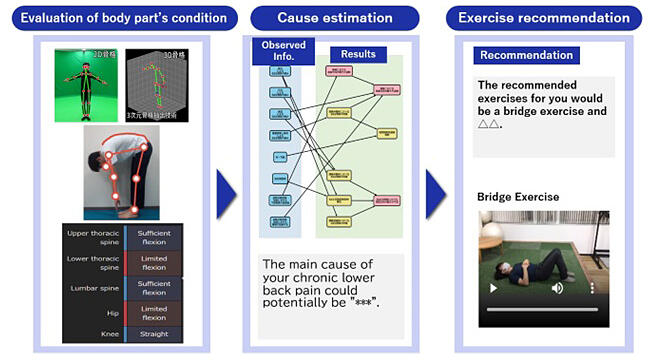NEC and Tokyo Medical and Dental University (TMDU) announced on March 21 that they have developed a technology to support self-care of chronic nonspecific lower back pain using AI to analyze video and medical interview data captured by smartphones and tablet devices. A media briefing was held, and an overview was presented by Director Masahiro Kubo and Chief Researcher Yuki Kosaka of NEC Biometrics Research Laboratories and Professor Koji Fujita of the Division of Medical Design Innovations of TMDU Open Innovation Center. The effectiveness of this technology is planned to be verified by conducting a demonstration in fiscal year 2024 at "NEC Karada-Care Kagurazaka," a health care facility that the two parties have been operating as a demonstration project since June 2021.

Provided by NEC
According to the Ministry of Health, Labour and Welfare's "Comprehensive Survey of Living Conditions 2022," back pain is the most prevalent subjective symptom of illness or injury in Japan for both men and women and is considered a national affliction. Lower back pain often becomes chronic and is a major health problem, and there are concerns that lower back pain may cause problems such as increased social security costs, including those from medical and nursing care benefits. However, to improve symptoms of chronic lower back pain the cause must be identified, which is not as easy as in lumbar disc herniation, meaning patients have to visit the clinic several times a month for a long time. This means many patients are unable to receive adequate treatment services because of distance and time constraints. In addition, given the growing population of aged people in Japan, there are expectations that technology will be developed that helps people with chronic lower back pain perform appropriate exercises to improve symptoms and prevent aggravation or recurrence of lower back pain.
The group has developed self-care support technology based on NEC's state-of-the-art AI, including 2D/3D skeleton estimation technology and abductive reasoning technology, and TMDU's medical knowledge. It is a simple and convenient technology that uses images of the user taken with a camera of a smartphone or tablet device. Based on the images, AI automatically estimates skeletal structure, evaluates the condition of each body part, estimates the cause of chronic lower back pain, and suggests an exercise program tailored to user's symptoms of lower back pain. When a user uses the camera of a mobile device such as a smartphone to take images of him/herself, they are normally two-dimensional images taken from various angles. The estimated skeletal structure may be distorted depending on the shooting angle, resulting in deterioration of the accuracy of the estimated skeletal structure. To address this problem, they developed a 2D/3D skeleton estimation AI technology that automatically considers the angle of the user appearing on the camera during estimation of the skeleton. This technology enables highly accurate skeleton estimation even from images taken from various angles.
To find the cause of chronic lower back pain, physical therapists and other specialists observe different movements of the patient, such as forward bending, backward bending, and rotation. They then evaluate the condition of various body parts as "insufficient," "moderate," or "excessive" joint flexion based on the relationship between the body parts, such as the angle between the pelvis and thighs, and the relationship between the body parts and the shape of the back. In contrast, conventional imaging technology evaluates the condition of each body part by calculating the relationship between body parts based on the skeletal information estimated from the images. However, the accuracy of the evaluation done by physical therapists is limited because the relationship between body parts and the shape of the back is not considered.
In response to this the group developed a technology to precisely estimate the shape of the back from images. With the new technology, the condition of each body part can be evaluated as accurate as physical therapists by considering the relationship between the body parts and the shape of the back. To find the cause of chronic low back pain, it is necessary to comprehensively search for physical issues from a kinematic perspective that could be the cause, such as "excessive lumbar flexion," based on each individual's attributes, such as age, sex, and lifestyle, and observable information such as symptoms.
However, numerous combinations have to be explored in this approach, as conventional inference techniques require several hours to search for the cause. To address this issue, NEC has developed a proprietary abductive reasoning technology using an SAT solver (a program for solving satisfiability problems of logical propositions). With this technology, the major cause of chronic lower back pain can be estimated within approximately 10 s, based on images and interview data. Moreover, a knowledge base has been created based on TMDU's medical knowledge. The knowledge base includes multiple combinations of the condition of each body part, interview data, and the causes of chronic lower back pain, allowing for accurate and comprehensive estimation of the causes of chronic low back pain. Finally, the newly developed technology suggests on the device an exercise program suitable for improving user's chronic lower back pain, based on the cause of the chronic lower back pain estimated as outlined above.
Because this exercise program is provided with videos, people with chronic lower back pain can check the videos while they perform the exercise program at home or other places by themselves. NEC and TMDU explained that they will continue to verify the effectiveness of this technology and consider providing the technology as a cloud-based service in the future. Moving forward, NEC and TMDU also plan to expand the scope of application of this technology to neck and shoulder disorders.
This article has been translated by JST with permission from The Science News Ltd. (https://sci-news.co.jp/). Unauthorized reproduction of the article and photographs is prohibited.




